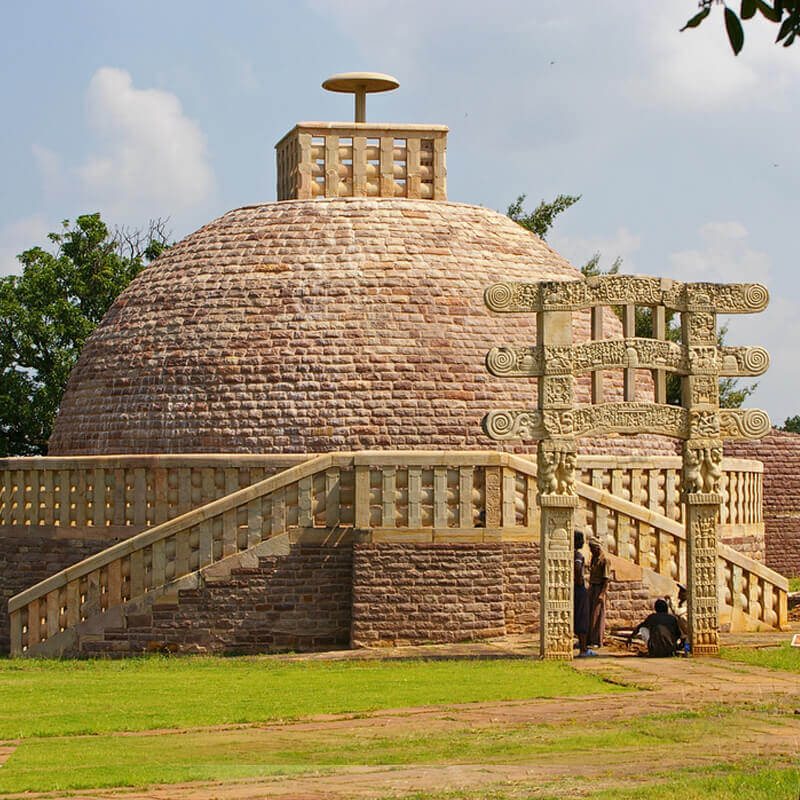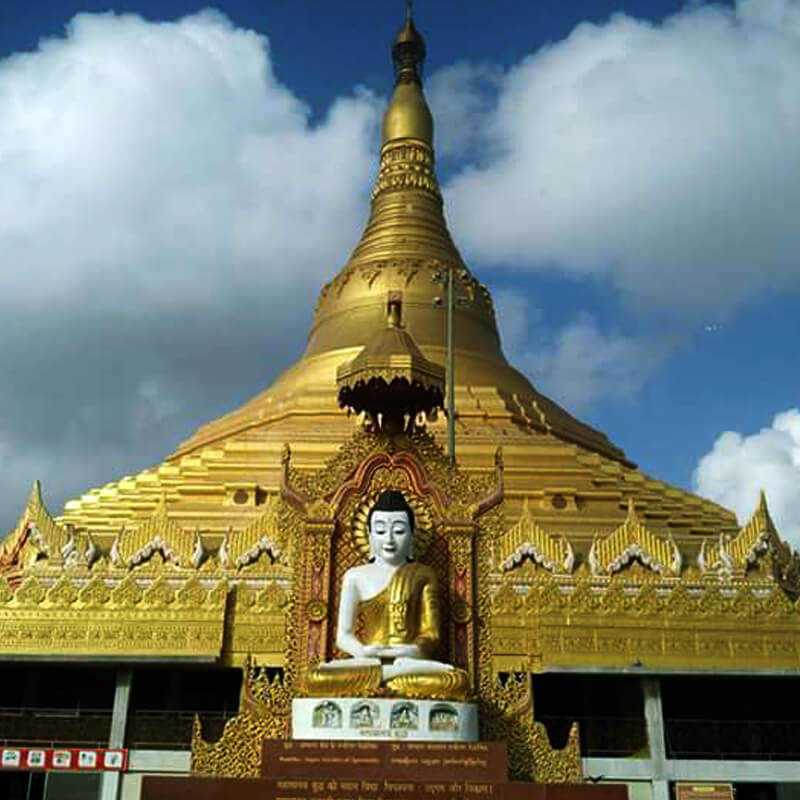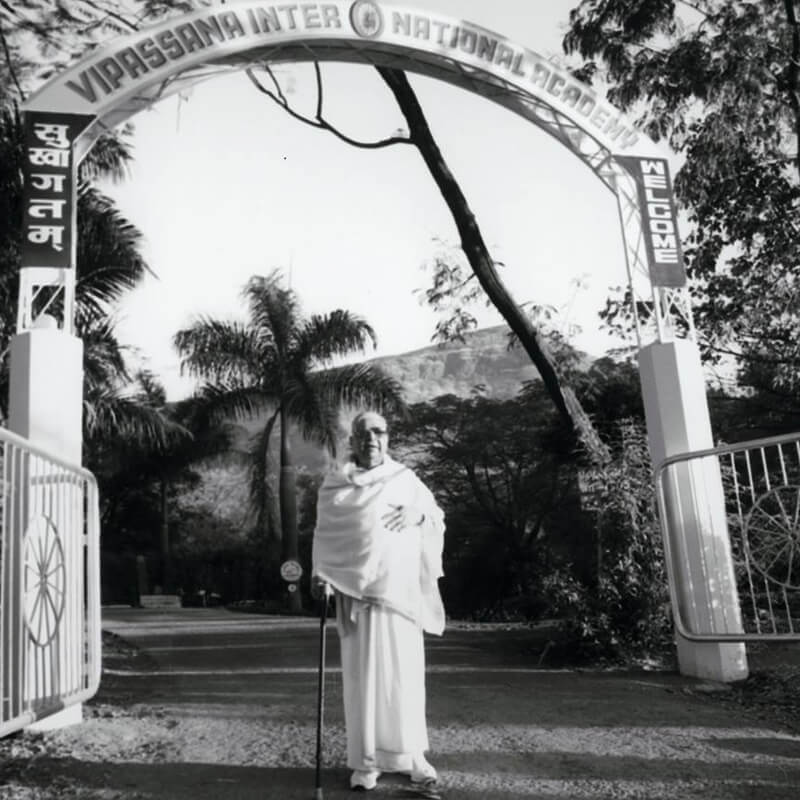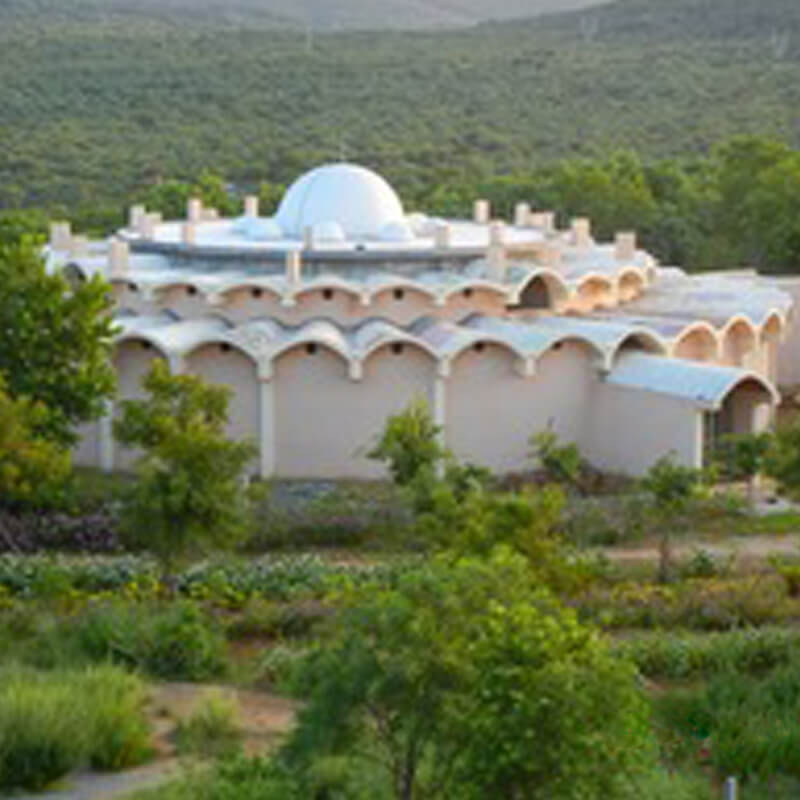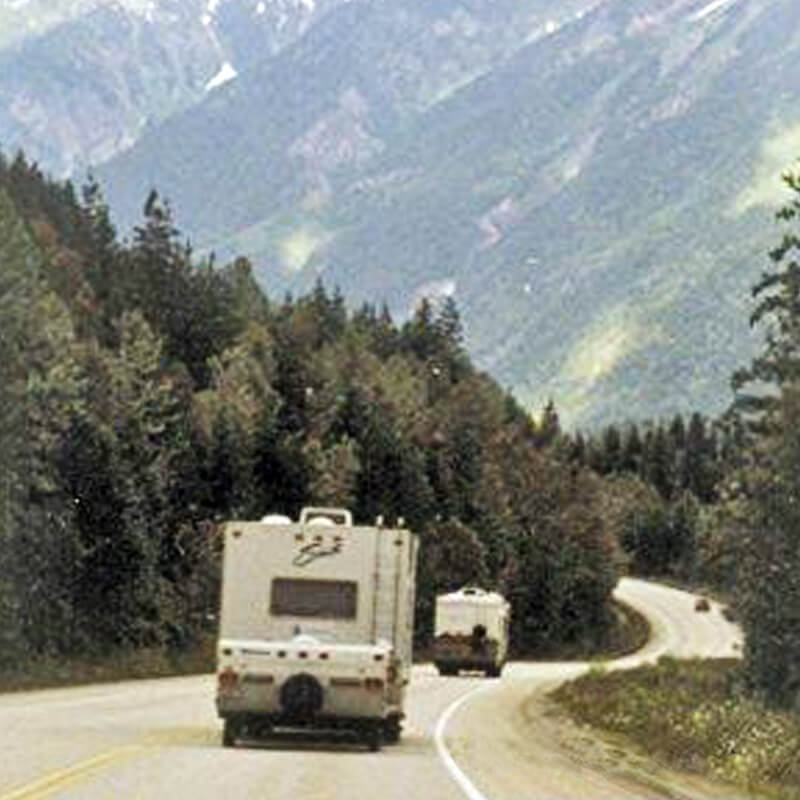A Profile
It has now been more than 30 years since the first seeds of Dhamma were planted in California. Over the years, these seeds have sprouted into many non-center courses and matured to produce two centers, Dhamma Mahavana and Dhamma Vaddhana.
Dhamma Mahavana, the older and more developed of the two, serves more than 200 students a month and has just completed building new private accommodations for male and female students. Work will soon start on other projects, including a pagoda for courses of 30 days or longer, and expansion of the kitchen.
With its large capacity and excellent facilities, Dhamma Mahavana is becoming a major Vipassana center in the West.
Initial Activity in California
Vipassana activity in California started in 1974, when old students of Goenkaji began publishing the Vipassana Newsletter from the San Francisco Bay area. The Newsletter was a vital source of information about the development of Dhamma Giri and especially about courses or events being held in India and the West. It was a lifeline for students in the years until Goenkaji began giving courses in the West. His first course in North America was in Montreal in 1979, and in 1980 he led a course for 225 students in Northern California. In 1981 he returned to California for the largest course ever held outside of India, with 350 people attending.
In 1982, Goenkaji appointed the first assistant teachers and two AT-led courses were given in California, both with attendance in the range of 300 students. In 1983 Goenkaji returned for still another large course.
From 1980 to 1983, five more non-center courses were held in California, with a combined total of 1,299 students.
The Early Courses
The following contribution from an old student gives a sense of the early courses:
The largest non-center course was for 350 people. This was an amazing experience, because in those days we did not get access to the site until the morning that the course was to begin. That meant the entire course had to be set up and the place had to be prepared before Goenkaji and the students arrived later in the day. Needless to say it was a terrific amount of work.
The day before the course, the main food staple at the site had been hot dogs, hamburgers and Kool-Aid. The dedicated crew of old students had to convert this greasy, grimy kitchen into a clean place to prepare vegetarian food for the course.
One year when we arrived, the room that Goenkaji was to use was filled with empty beer cans from a party that the departing camp councilors had held the night before. A mighty effort was made to clean the place up.
The well-known Skunk Train track ran right beside the site, but was mostly hidden by the deep growth of redwood trees. It wasnt until about 2 oclock in the morning when the train passed through, loaded with lumber and blasting its loud whistle into the night, that we really became aware of it. From then on we were treated to that sound twice a day. The day run was usually during the 2:30 group sitting.
Also at this site there was another interesting experience. Just before 7 oclock one evening a visitor arrived who had been invited to attend the discourse. He was quite concerned that he had driven an hour to the site to hear the discourse and no one was there. Where were all the 350 people that he had heard were supposed to be meditating here, he asked. It was pointed out to him that they were a few feet away in the huge tent. A few minutes later you could hear the chanting and Bhavatu Sabba Mangalam and 350 people began emerging from the tent silently walking to take a short break. This visitor was overwhelmed by the fact that so many people had been just a few feet from him meditating so quietly and that he was totally unaware of it.
Forming a Trust and Searching for Land
The first trust in California was formed in 1974, at the same time as the Vipassana Newsletter. All of the Dhamma activities in California up until 1983 were conducted under the auspices of this trust. In 1983, old students of the region founded a new trust with the specific goal of finding a site for a Vipassana center in the Bay Area. That same year, the trust rented a property in Nicassio. This “Dhamma House” was the first site in California used exclusively for Vipassana activities.
One year later, in 1984, a substantial donation from an old student made it possible for the California Vipassana Trust to purchase a house on six acres in Occidental, near Santa Rosa. It operated as a Dhamma House until Goenkajis visit in 1987, when it officially became the first California Vipassana Center. By 1989, the number of students wanting to take courses had outstripped the capacity of the center. Since zoning issues prevented expansion, the search for another site began.
The trust limited its search to properties within four hours driving distance of San Francisco, especially between there and Mendocino to the north — home to many old students who were active in the trust.
The trust found two suitable properties not previously used for retreat centers, but it was unable to get a use permit for either. It then decided to limit the search to properties with an existing use permit as a camp or retreat center. Shortly after this, the trust president heard about a property near Fresno. This was not an area in which the trust had been looking. The search committee went to visit one facility in North Fork, and made an offer that was declined. But another property just a half a mile away became available, and it too had an existing use permit. It was a more attractive parcel, and this time the trusts offer was accepted. The sale was concluded in January 1991, and approval came the following March for the the center to be used for up to 75 students.
There were no old students living in the area or within a short drive. As a result, at the end of each course, the center was locked up and everyone left until set-up for the next course began.
However, because North Fork had such reasonable housing prices, over the years many people were able to move there and buy homes. The student base became the most valuable resource for the center. Today, there are approximately 20 old students living in the area.
Site Development
Several structures came with the purchase of the property. There was a large 3,000 square foot house in very good condition, a small newer barn, an old barn, three cottages, a newer double-width mobile home, a single-width mobile home with an addition, six small cabins, and a building that the previous owners used for a kitchen and dining hall. It had a total of 15,000 square feet of improvements. Everything was in average condition and needed lots of soap, elbow grease and paint.
The first challenge was to convert the facility from a childrens camp into a meditation center. There were only three weeks from the time of taking possession of the property to Day 1 of the first scheduled course. With the untiring efforts of a few Dhamma workers and several well-attended work weekends, the large kitchen-dining hall was transformed into a meditation hall, the existing cabins and residences were cleaned and beds were moved in to create dormitories.
On April 25, 1991, 36 students plus six full-time and two part-time servers participated in the first 10-day course. The Wheel of Dhamma began to rotate at the newly inaugurated center.
Shortly thereafter, work continued apace. The three-car garage was converted into a kitchen, buildings were painted, and showers and toilets were installed. The master bedroom and adjacent large room became the AT residence and interview room. Preparations were finished just in time for the course conducted by Goenkaji in August, 1991, for 100 students and more than a dozen servers. The English discourses that are now used throughout the world were videotaped at this course.
Goenkaji gave the name to the center before he ever visited it, while he was still in India. The name Mahavana means large or great woods. He was given a description of the site and told of the forest there, which consisted mostly of ponderosa pines, manzanita and fir. On this initial visit Goenkaji toured the entire property and chose sites for the meditation hall and pagoda.
Each year, a new project was undertaken. First a new caretakers cottage was built. Next, one of the two barns (initially used for storage) was converted into the office, mens dining hall and servers quarters. The kitchen was remodeled. Step by step the center began to take shape. In 1996, the new meditation hall was built, followed in 1997 by the teachers residence. The area between these two buildings is the site for the planned pagoda.
“At the ideal center,” Goenkaji says, “each individual lives separately and practices separately in a small cell.” With the remodeling of the old meditation hall into 10 private rooms in 1998, facilities to meet this ideal were taking shape. In 1999, the kitchen and womens dining hall were remodeled. In 2000, a master plan for the center was completed, and construction began on new student accommodations in 2001. In 2002, a new 10,000 gallon water tank was installed, and three new pressure tanks were added to the water system. A new pump house was also built.
With its large acreage, dry climate, and shortage of water, Dhamma Mahavana requires maintenance projects not found at other centers. Brush clearing operations are a regular part of land stewardship to prevent potential forest fires from spreading into the center. Grading and graveling of roads and erosion control on paths are other ongoing projects.
Present Day
Dhamma Mahavana now has a Dhamma hall that can seat up to 128 students. The center can accommodate a total of 127 students at maximum capacity, with some students camping in tents and the rest accommodated in dormitory-style rooms, semi-private rooms and private rooms with shared baths. Registration is done both on and off site using remote registration software.
There are full-time managers on site, as well as long-term servers. Four to five rooms are currently set aside for long-term servers, and eventually additional long-term server accommodation will be constructed. The water system is being upgraded to handle the current needs and future expansion of the center.
There is a caretakers cabin, maintenance shed, and an office that houses the server for the registration program used by most of the centers in North America.
The men’s and women’s dining halls are also in need of expansion and more private accommodations with attached baths are needed. The master plan includes private accommodations for 70 students initially, with the intention to eventually bring this up to 120 students. Recently three new accommodation buildings were completed, with private rooms and shared bathrooms. While additional accommodation is still a high priority, the focus will now shift to the pagoda and a mens toilet block near the Dhamma hall and pagoda area.
Construction of the Pagoda-2016
Since last October, the skyline of the California Vipassana Center has had a unique addition: the graceful, soaring, golden shape of a pagoda (zedi in Burmese), modeled on the famous Shwedagon Pagoda in Yangon, Myanmar. It took only a few days to assemble the zedi on the roof of the center’s meditation cell building. But this was a crucial step in an effort that had been under way for years—you could say, for millennia—and that still continues.

California Vipassana Center, Dhamma Mahavana
Beginnings
The Burmese word zedi is from the Pali cetiya, meaning a mound or cairn. Another Pali word with the same meaning is thūpa; the Sanskrit version, stūpa, has found its way into English. In ancient times in India, structures of this type were built at places associated with the Buddha and his teaching. Originally, they were simple heaps of earth or wooden constructions. Gradually, they became more and more elaborate.
When the teaching spread to neighboring countries, the practice of building such monuments went with it. Different countries each developed their own architectural style, which changed with the passing years. In Bagan in central Myanmar, thousands of zedis erected through the centuries still stand to honor the Buddha and the Dhamma. But the country’s largest and most venerated pagoda is Shwedagon, a solid mass of masonry covered with gold plates and rising to a height of 99 meters (325 feet). In modern times, builders of zedis have followed its design.
This was the design that inspired Sayagyi U Ba Khin in the early 1950s, when he founded the International Meditation Center in northern Yangon. The upper level of the center’s two-story meditation building is a small octagonal structure. In the middle is a meditation room for the teacher and senior students. Surrounding it are eight individual meditation cells. Above the central room is a large zedi, and a smaller one stands atop each of the eight cells around it. Unlike Shwedagon, though, each zedi is hollow, forming a dome over the room beneath. The hollow zedi, in fact, is a return to a style of construction found at some archaeological sites in India, dating back to the centuries immediately after the time of the Buddha. (See “Living Pagodas,” in the December 1989 issue of the Newsletter.)
In the early years at Sayagyi’s center, a terrace surrounded the upper level of cells. Here meditators could walk or sit during breaks. On the southern horizon, they could also see a blink of gold where Shwedagon was standing. One pagoda called to the other.
In the 1970s, when the first pagoda was built at Dhamma Giri, Goenkaji gave instructions to follow the design of Sayagyi’s center. Later, as the number of cells grew into the hundreds, a larger zedi was installed above the original one.
In time, Goenkaji hoped that centers around the world would have meditation cell buildings topped with a zedi. These would remind Vipassana meditators of their debt to Myanmar and Sayagyi U Ba Khin for the gift of Dhamma.
From the base to the uppermost tip, all the features of the zedi have significance. They include the alms bowl of one who has renounced worldly life; the lotus blossom, rising pristine above muddy waters; the banana bud, with no essence or hard core; the seven-tiered umbrella, emblem of royalty; and at the very highest point, the jewel of enlightenment.
Meeting the challenge
By the late 1980s, the first centers in Australia and the United States were ready to build cells, but a zedi-style roof was a considerable challenge. One concern was that neighboring communities might regard a zedi as a kind of temple, and might decide that Vipassana was a religious cult. Even if they didn’t go that far, neighbors might object to an unfamiliar style of architecture.
Other concerns were more practical. There were no blueprints for a structure of this type, and architects in the West had no experience with zedi building. Even if they drew up blueprints from scratch, they would probably have to adapt construction methods. Zedis were usually built of stone or bricks and mortar; it would be difficult to construct one on site. Another problem was the possible damage caused by expansion or contraction as a result of climate extremes in some countries. When most centers were still struggling to build basic facilities, a zedi seemed unaffordable.
A number of centers in the West went ahead and built meditation cell complexes, which they called pagodas. But either the roof was flat or it was a modified design that was easier to construct and more likely to blend in with the surroundings.
This was where things stood until the mid-2000s, when an American meditator named Jim Kahn decided to do something about it. Jim was a contractor and building management specialist who had experience working with Vipassana center construction. He had overseen major building projects at Dhamma Mahavana in California, Dhamma Dhara in Massachusetts and Dhamma Patapa in Georgia. He decided to go to Myanmar, learn how to build a zedi and see whether there might be a more efficient way to provide zedis to Vipassana centers around the world.
So began a decade-long effort. Jim had to face innumerable obstacles, including language barriers, health issues, bureaucratic red tape, political turmoil and simple cultural misunderstandings. But he succeeded in assembling a team of enthusiastic young architects from Myanmar, who were teaching themselves computer-assisted design (CAD). Together, they drew on the knowledge and craftsmanship of expert zedi builders, heirs to an age-old tradition. The team then had to find a way to carry on that tradition, using modern technology and materials. An extra challenge was that thezedis they sought to produce would have to be easy to ship around the world, highly durable and able to withstand variations in weather.
Using 21st-century construction and computer skills, the team solved the problem. It was an elegant and astonishing solution.
The traditional craftsmen created models in concrete and wax. The design team then entered the measurements into a CAD program. This enabled them to create molds with which they could fabricate architectural elements with great precision.
They experimented with different materials and finally settled on reinforced fiberglass because it is strong and lightweight. Through trial and error, they learned to produce zedis and other ornaments that replicated Shwedagon in exquisite detail. The result was breathtaking.
The Journey and Arrival
In the early days, Thai meditators helped the team set up operations near Bangkok. Later, the designers established their workshop in Yangon. In 2013, they shipped eight small zedis to the California Vipassana Center. In early 2015, they shipped the large zedi and architectural ornaments.
Meanwhile, at Dhamma Mahavana in California, a meditation cell building had come into use in 2011. The smaller zedis had been set up in 2013. Now the roof had to be braced and prepared for the largezedi that would sit atop it.
The shipment from Myanmar arrived in May 2015. By late October, everything was ready for installation. A team of professionals were on hand to do most of the work, and meditators assisted where they could. Hovering overhead was a drone recording the event. Day by day, the work proceeded, and spirits mounted as the structure rose higher.
On October 24, when the main zedi was ready, two meditators standing in a cage hanging from a crane carefully slid the crowning umbrella into place, completing the structure.
Now it was clear how right Goenkaji was to set meditators the task of building zedis at Vipassana centers far from the land where the Buddha lived, and far from the land that preserved the Buddha’s teaching through millennia. The soaring zedi is a 3-D representation of the process of purification. It awakens gratitude in meditators, and inspires them to work toward the highest goals.
In the coming months, zedis from Myanmar are scheduled to be installed at Dhamma Dhara in Massachusetts in the eastern USA. The turn of other centers will come later. In every case, the zediwill long bear witness to our tie to Myanmar, to Sayagyi U Ba Khin and to Goenkaji—the land and teachers that lovingly shared with us the teaching of liberation.
(Courtesy: International Vipassana Newsletter, August 2005 and April 2016)

